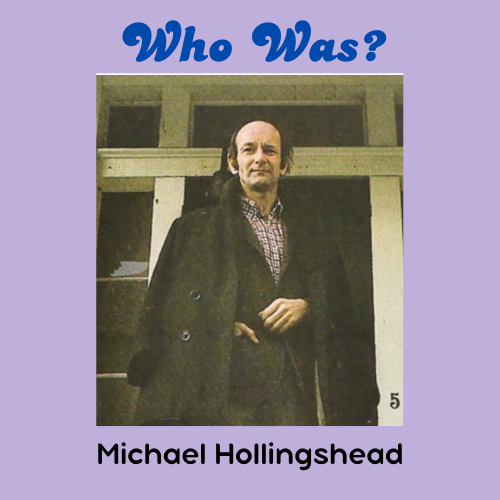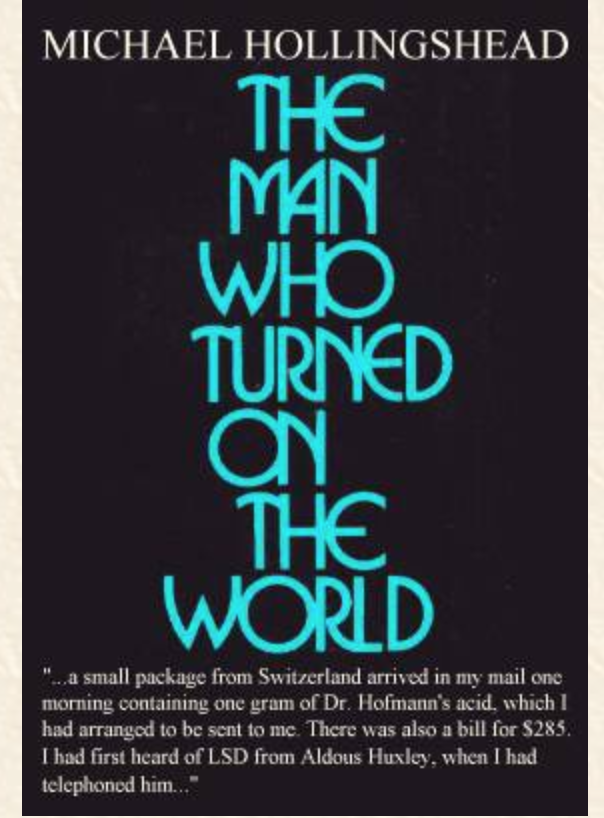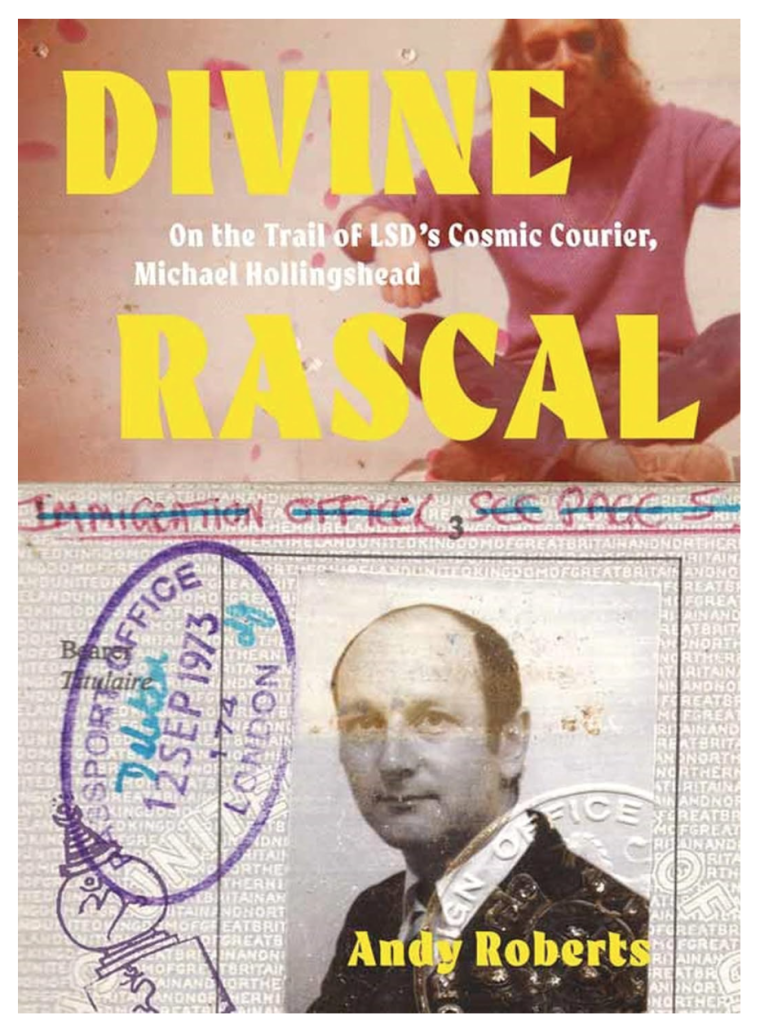Psychedelic Substance known for: LSD
Year: 1961

Michael Hollingshead (born Michael Shinkfield) in Darlington (County Durham) in the north of England. It is rumoured that born as a working-class Shinkfield, transformed himself in to an Oxford-educated gentleman with a new posh accent. Thus he became “Michael Hollingshead,”.
In 1960 he was living in New York, working as the executive secretary of the Institute for British American Cultural Exchange.
The department ordered a gram of LSD from Switzerland under the pretext of using it for controlled studies.
Dr John Beresford received a package of LSD from Sandoz Laboratories in Switzerland and he gave one gram of it to Hollingshead.
One experiment Hollingshead conducted involved studying the effects on web-weaving by spiders under the influence of the drug.
The small package arrived from the Sandoz corporation in Switzerland, containing one gram of LSD, roughly five thousand hits.
He mixed the LSD into a sixteen-ounce mayonnaise jar. He decided to mix the acid with water and icig sugar, making 5,000 one-teaspoon doses of 200 ug each.
He had never tried LSD and, after his first strong experience, he contacted Aldous Huxley who suggested that he speak with Timothy Leary to discuss LSD’s potential.
In September 1961, he met Leary in Cambridge, and shortly thereafter he introduced Dr Timothy Leary to LSD.
Dr Leary was an American writer, psychologist, futurist, and advocate of psychedelic drug research and use.
Timothy Leary and Richard Alpert (Ram Dass) conducted experiments which were part of their personal discovery and advocacy of psychedelics. The experiments known as the Harvard Psilocybin Project took place from 1960. Other professors in the Harvard Center for Research in Personality raised concerns about the legitimacy and safety of the experiments in an internal meeting. The concerns were then printed in the Journal the Harvard Crimson and the publicity resulted in the end of the official experiments, an investigation by the Massachusetts Department of Public Health (that was eventually dropped), and firing of Leary and Alpert in 1962.
He was invited to live in Leary’s house as well as teach a course at Harvard.
He proceeded to take the Harvard psychologist on his first LSD trip in December 1961.
He then went on and participated in the Concord Prison Experiment with Leary, Cohen, and Meztner in 1962-63. The study involved the administration of psilocybin to assist group psychotherapy to 32 prisoners in an effort to reduce reoffending rates. The experiment was designed to evaluate whether the experiences produced by psilocybin could inspire prisoners to leave their antisocial lifestyles behind once they were released. 25 per cent returned.
He was involved in The Good Friday Experiment of 1962 (where volunteers from Harvard’s Divinity School explored the spiritual properties of psilocybin), and the Millbrook commune.
Millbrook was a private mansion in Millbrook, New York, which was owned by Billy Hitchcock, an heir to the Mellon fortune.
Timothy Leary, Richard Alpert (AKA Ram Dass) and Michael Hollingshead retreated there.For the next few years, he worked with psychedelic therapists, and lived at Millbrook with Leary and Richard Alpert (Ram Dass).
Hollingshead eventually ended up back in the UK in London. At his flat in Belgravia’s Pont Street he opened the World Psychedelic Center in 1965.
He used what he believed to be the key elements needed for a good trip: bowls of fruit, handwoven cloth, open fire, bread, cheese, wine, candles, incense and goldfish. A chill out space.
At the Center, he sold copies of psychedelic books and continued to “spread the word” about LSD.
Some of the many people who Hollingshead is credited as having given LSD to include William Burroughs, John Lennon, and George Harrison; he is widely considered to be one of the “Johnny Appleseeds” of LSD.
In 1966, the London police raided the WPC and found some cannabis that Hollingshead had failed to flush down the toilet, he was given a sentence of 21 months in Wormwood Scrubs.
After his release he went to Kathmandu, where he experienced ‘samadhi’ when Gyalwa Karmapa, a Buddhist monk, gently touched his forehead while he was tripping on LSD. “I felt utterly and completely cleansed,” he wrote, “as though the divine thunderbolt had gone through me like a million volt charge.”
He also worked in experimental film, collaborating on the Scott Bartlett short subject “A Trip to the Moon”, in 1968
Hollingshead is an associate of the Castalia Foundation, a contributor to the Psychedelic Review, and interviewed Robert Anton Wilson for High Times Magazine in 1980.
In a 2018 interview, Hollingshead’s daughter Vanessa said that her father died in Bolivia from a stomach ulcer in 1984.
The Public Michael Hollingshead
The opinions of Hollingshead were initially formed when he published his psychedelic memoir, The Man Who Turned on the World, in 1973.

From his roots in working class darlington, he became “a worldly raconteur with a serious appetite for travel, adventure, and mind-altering drugs” (Andy Roberts’s biography of Hollingshead, Divine Rascal).

Historians who have read the autobiography did not seriously question Hollingshead’s version of his own life. In Divine Rascal, Roberts questions the history.
Roberts uncovers the fact that Hollingshead was not simply a benevolent trickster who turned people on with his beloved mayonnaise jar; he also possessed a dark side — one that does not appear in the various historical accounts of the psychedelic movement.
Roberts, is a historian of British psychedelic culture (e.g., Albion Dreaming: A Popular History of LSD in Britain [2012].
The science of the 1960s and the present day has verified, LSD, when used humanely and therapeutically, can help and benefit people.
Articles about Michael Hollingshead
- Hollingshead, Michael & Timothy Leary, George Litwin, Günther Weil, Richard Alpert (1962) The Politics of the Nervous System. – The Bulletin of the Atomic Scientists (1962) by Atomic Scientists of Chicago, Educational Foundation for Nuclear Science (Chicago, Ill.) (response to Psycho Chemicals as Weapons by Dr. E. James Lieberman – January 1962)
- Hollingshead, Michael (1973) The Man Who Turned On the World. Abelard-Schuman Publ. New York (also Blond & Briggs, Ltd.)
- The Sayings of Michael Hollingshead. Blotter Magazine Issue #3
- Hollingshead, Michael (1968) Introduction to “Lightshow” Harbinger Magazine (produced by the Oracle staff as their 13th issue and attempted revival of the publication) Harbinger University Press, July 1968. by Michael Hollingshead
- The Man Who Turned on the World, his 1973 autobiography.
- Harris, Lee & Chris Render (1994) Best of Homegrown Red Shift ISBN 0952435004 (contributor to anthology of Homegrown Magazine)
- Robert Anton Wilson: The Author of The Illuminatus Trilogy Expounds on Multiple Realities, Guerrilla Ontology, LSD, Life Extension and Things that Go Bump in the Night by Michael Hollingshead. High Times (1980)


